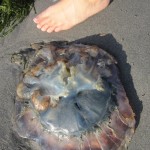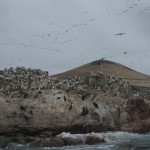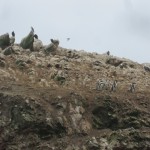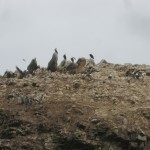We heard that just off the coast, the Islas Ballestas were Peru’s ‘Poor man’s Galapagos’, a description that perhaps exaggerates a little – but then we’d heard they were covered in guano, so our expectations were pretty low!
We stayed in the quaint little beach town of Paracas, in ‘Paracas Backpacker’s House’ with rooms more like beach-huts than proper buildings. Ours had a flat roof with holes through to the sky – this is where the desert meets the sea, and it basically never rains here. If it did, those live wires running onto the roof would be a bit more concerning! It was one of the nicest places we’ve slept in ages – the owner Alberto was wonderful, giving us all sorts of tips for eating cheaply in the town, telling jokes and making us very welcome. It was the first time we’ve been on a beach since Salvador back in Brazil over 3 months ago, so we were both pretty excited despite the cool weather!
Early in the morning, we took a tourist speedboat out to the islands – you can’t actually set foot on them to protect the inhabitants, but the view from the boat was just fantastic. The whole thing was pretty Hitchcockesque; there are hundreds of thousands of birds absolutely everywhere, covering every rock as far as the eye could see. The hill in the centre of the island had a black tinge to it, and as we got closer, you could see it was actually a seething mass of avian life – the black was all birds.
On the way to the islands we were greeted by sea lions leaping out of the water to welcome us, but the real highlight was waiting on the rocks – penguins! I hadn’t quite imagined them to be so small – cute at just 50-70cm high and looking sweet in their little groups. The island is absolutely covered in Peruvian Boobies, a white-headed bird, with spots of red-footed cormorants, and the suitably ugly turkey culture. The swarms of birds flying overhead in formation brought back memories of the starlings over Brighton in autumn – although in this case, it was the distinctive silhouette of pelicans instead.
The birds bring more than just ecological riches to Peru, as the bird droppings (guano) they produce is hugely valuable as a fertiliser. Two people actually live on the islands at all times to guard the product, with stone walls created to ensure the excrement doesn’t (ahem) get flushed away – in places, it is metres thick! Every seven years the whole lot is collected – a dirty job if ever there was one – half to be exported and half for Peru’s domestic agriculture.
Following its failed war with Chile, Peru was in massive debt and needed to raise funds to pay off foreign loans. It seems only appropriate that for a country that could be said to be ‘in the shit’, it was the money from exports of guano that solved the national financial crisis at the time – pretty valuable stuff! On a weekend when Spain is turning to the Eurozone to bail out its banks, it does make you wonder – perhaps they could follow a similar route? The perfect counterpoint to a faltering tourist industry?
Simon
- Sunset over the Pacific. Yes, this is still Peru!
- This thing was huge!
- Sealions
- Peruvian Boobies sitting on the rocks
- This is where they load up the Guano. Lots and lots of birds!
- Birds on the Jetty
- Reminds me of the starlings in Brighton
- Some tiny Penguins
- Those Penguins again












